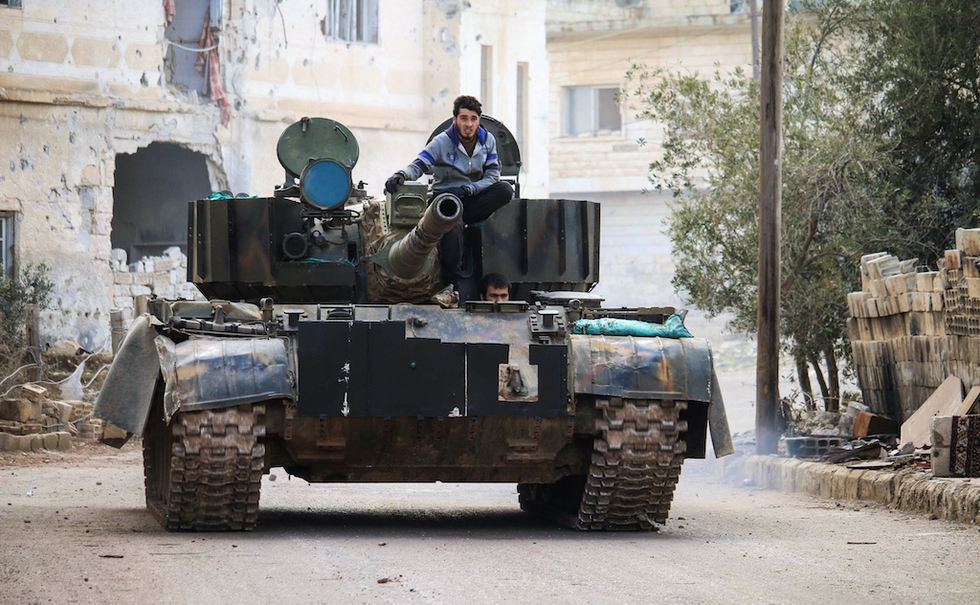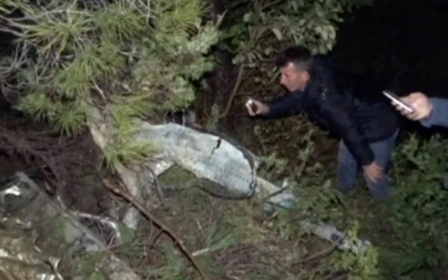New 'caliphate' rises in south Syria as IS loses grip on the north

BEIRUT, Lebanon - While the Islamic State militant group is losing ground in Iraq and northern Syria, a close affiliate is amassing territory and power in south-west Syria, just a few kilometres from the Jordanian and Israeli borders.
In the early hours of Monday 20 February, the Jaysh Khalid bin al-Waleed group, thought to number about 1,000 men, surged out of its stronghold in the Yarmouk River basin and stormed into several opposition-controlled villages nearby.
Local opposition groups fighting under the Free Syrian Army umbrella responded but were unable to push the militants back.
Activists and analysts agree that the attack was designed to break a long-running siege on the Yarmouk Valley and give Jaysh Khalid a chance to stock up on supplies including aid goods, weapons and vehicles. But the operation was no smash and grab.
Jaysh Khalid is getting stronger, they took vehicles and weapons from FSA-controlled areas
- Tseel resident
Rather than loading up and heading back to their traditional stronghold, fighters from Jaysh Khalid dug in, first taking control of Tseel (UN estimated population 34,000) and then Jileen (9,200) and Adwan (4,900).
Two days later, UN humanitarian chief Stephen O’Brien warned the UN security council that curfews were in effect in these areas, limiting civilians’ mobility, and that many NGO staff had been unable to flee before the attack "and have now gone radio silent in these villages"
Within a week Jaysh Khalid began distributing aid goods – mainly foodstuffs – in Tseel, the largest population centre newly under its control. The group is also accused of looting and redistributing a range of other supplies – tactics that appear designed to cultivate the goodwill of the local population.
But one Tseel local reached by MEE said he was terrified at what the group had done so far, and what they might do next.
"I think Jaysh Khalid is getting stronger, because they took vehicles and weapons from FSA-controlled areas," he told MEE.
The man asked that his name be withheld to protect his security.
A rising body count
Heavy combat, much of it hand to hand, has generated some of the highest casualty numbers southern Syria has seen in more than a year. On 1 March, the Britain-based Syrian Observatory for Human Rights (SOHR) said 11 civilians, 104 opposition fighters and 48 Jaysh Khalid members had been killed in the fighting.
Ongoing fighting in the village of Mazariya, where opposition militants still hold control, has pushed the death toll higher still, local activists say. At the time of publication Ahmad Ali, an activist based in Tafas, just four kilometres to the east of the area Jaysh Khalid controls, said he knew of 180 opposition fighters and 70 Jaysh Khalid members who had been killed.
Social media has been awash in photos of decapitated FSA fighters, their heads positioned atop prone bodies
Like the Islamic State group, Jaysh Khalid employs a particularly brutal brand of combat tactics, favouring suicide operations and beheadings.
Social media has been awash in photos of decapitated FSA fighters, their heads positioned atop prone bodies, a grisly display reminiscent of Islamic State media productions.
Though the FSA has brought more men, weapons and vehicles to the battle, they have been curiously outfought from the beginning.
Daraa locals have long whispered of "Daesh sleeper cells" across western Daraa. Activists say that by activating these, Jaysh Khalid has dragged local FSA factions, already engaged in a battle with government forces in Daraa city, into a battle on two fronts.
Fears in Amman
Yet this isn’t the only factor. According to security insiders, Jaysh Khalid’s recent surge has caused enormous frustration for the US-backed Military Operations Centre (MOC) in Amman, which has drip-fed weapons, tacticals and funding to vetted opposition factions since 2013.
In an ironic twist, Jaysh Khalid’s primary predecessor, the Yarmouk Martyrs Brigade, was itself supported by the MOC until 2014.
In recent months, the MOC has encouraged and even strong-armed the groups it supports into taking Jaysh Khalid on, but little has happened. Despite supposedly being under siege since at least mid-2016, the group hasn’t shown any signs of weakening.
In late November, Israeli warplanes targeted a Jaysh Khalid location in the southern Syrian Golan Heights, and in early February Jordanian warplanes did the same. Both incidents were the first of their kind, but neither seems to have slowed the group’s momentum.
The southern rebels are militarily ineffective and split into too many factions, and corruption has impeded the fight against Jaysh Khalid
- Aymenn al-Tamimi, analyst
Insiders say the MOC recently instructed the Fallujat Houran FSA group to take over a checkpoint outside Jaysh Khalid’s Yarmouk Valley stronghold, replacing FSA fighters from the nearby city of Nawa, who were thought to have been allowing militants to come and go.
This, too, didn’t work: Jaysh Khalid was able to plan and execute an operation that seems to have caught everyone by surprise – including the very opposition fighters paid to keep them behind siege lines.
"Something was clearly in the works," said analyst Aymenn al-Tamimi, pointing to recent administrative shifts within Jaysh Khalid ahead of the recent surge.
But Tamimi believes a significant factor in recent events has been the weakness of the rebels in the south – something Jaysh Khalid appear to have understood and taken advantage of.
"The southern rebels are militarily ineffective and split into too many factions, and corruption has impeded the fight against Jaysh Khalid. For example, some [Jaysh Khalid] personnel have been able to get in and out despite the siege condition imposed – which means it is clearly not fool proof," he told MEE.
Lack of will to fight
There’s another, more prickly issue: not all FSA groups are necessarily interested in defeating Jaysh Khalid.
The southern rebel spectrum runs from the secular to the Islamist, and activists say some of these groups are unwilling to kill other Muslims, such as Jaysh Khalid.
No fighter or activist interviewed for this article would say so on record, for fear of losing MOC support – scant as it is.
But in December 2016, Tamimi wrote of an interview with a former Jaysh Khalid member, who explained why the MOC-fed FSA hadn’t defeated the group already: "There is no fighting. The battles have become something agreed upon… only for photography."
The brutality and spread of this latest offensive may have spurred the opposition to take more meaningful action.
On 1 March, news surfaced of a new Free Syrian Army operations room set up to take on Jaysh Khalid. Sixteen groups are named in the announcement, including six groups – the Omari Brigades, al-Hamza Division, Ahrar Nawa, Jaydour Houran Brigades, Jaysh Ababeel and the 46th division – that are supported by the MOC.
It’s early days for this new operations room, but the battle – in Mazariya and on the road to Nawa – is ongoing.
A new caliphate?
According to the FSA’s press releases, the mainstream opposition is making gains on the southern militants. Tamimi is more guarded in his predictions.
"I don’t see a defeat for Jaysh Khalid anytime soon," he said.
Defeating the group would involve two steps. It would first have to be forced back into its Yarmouk Valley stronghold, as the FSA did in summer 2016 after Jaysh Khalid’s previous offensive, which was smaller-scale and shorter-term than this one.
The second step would be to take the group on in this location – something Tamimi thinks will be difficult.
"Besides the rebels’ weaknesses, Jaysh Khalid’s terrain has a lot of high ground. It’s difficult to breach," he said.
Behind Jaysh Khalid lines, the view is darker. The Tseel local told MEE that while he held out hope that the FSA will be able to wrest his village back to mainstream opposition control, he believed the group has broader aims.
"I think Jaysh Khalid wants to establish a caliphate in western Daraa. It makes a strong statement if they can do this, next to Israel and Jordan and close to Damascus. For them to have a strong presence next to these borders is strategic, because they are close enough to shell or bomb Israel or Jordan," he said.
"The people in this area are very worried."
New MEE newsletter: Jerusalem Dispatch
Sign up to get the latest insights and analysis on Israel-Palestine, alongside Turkey Unpacked and other MEE newsletters
Middle East Eye delivers independent and unrivalled coverage and analysis of the Middle East, North Africa and beyond. To learn more about republishing this content and the associated fees, please fill out this form. More about MEE can be found here.




